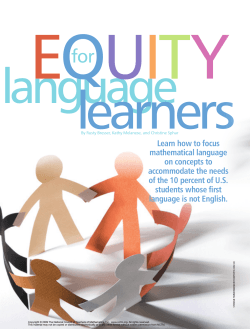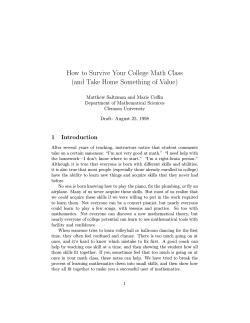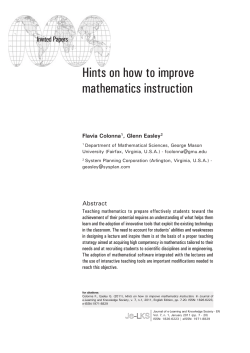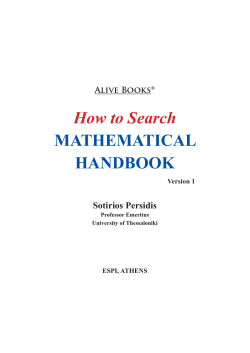
I Understanding and Supporting Children’s Mathematical Vocabulary
Understanding and Supporting Children’s Mathematical Vocabulary Development magine a teacher running her hands across her desk as she tells her students, “A plane is a perfectly I flat surface.” The students listen quietly, but one of them is thinking, “I thought a plane was something that flies.” As this example illustrates, the language of mathematics can sometimes be confusing. Many mathematical words are unusual, some terms have different meanings in everyday usage than in technical mathematics, and some are used in mathematics in more than one way. However, terms, phrases, and symbols are essential in communicating mathematical ideas; and becoming fluent with them is vital for children’s mathematical learning. In everyday English, new vocabulary can be assimilated into daily conversations; students’ opportunities to use the language of mathematics, however, often are limited. Teachers must present classroom activities in which children read, write, draw, and explain mathematical ideas. Our goal is for mathematical language to become fluid, natural, and, as Principles and Standards for School Mathematics states, a “powerful tool . . . to foster the learning of mathematics” (NCTM 2000, p. 128). As adults, we are comfortable with the varied meanings and implied understandings in words and phrases. In this article, we step back and consider how these words come across to children. Our work is built on the writings of Earp and Tanner (1980), MacGregor (1990), Shuard and Rothery (1984), Usiskin (1996), Thompson and Rubenstein (2000), and Whitin and Whitin (2000). To be more aware of, and sensitive to, issues of mathematical language acquisition and to be more creative and persistent in finding ways to support children’s learning, teachers must first understand children’s difficulties in making sense of mathematical language. This article begins by sharing difficulties children sometimes face in learning mathematical language and continues with strategies teachers may use to help prevent or overcome those difficulties. Language Challenges Table 1 outlines some common difficulties in learning mathematical vocabulary and lists one or more examples of each. As you study the table, we invite you to place the words below in one or more rows of the table and to think of additional words for the grade level with which you are most familiar. These terms were selected from a word list of a commercial textbook series. • Grade 1: square, foot, odd • Grade 2: cube, cent, face, sum • Grade 3: scale, factor/multiple, dividend, polygon, round • Grade 4: pictograph, isosceles, slide • Grade 5: radius/diameter, similar Rheta N. Rubenstein and Denisse R. Thompson Rheta Rubenstein, rrubenst@umd.umich.edu, teaches at the University of Michigan—Dearborn. She is interested in making mathematics accessible to all learners. Denisse Thompson, thompson@tempest.coedu.usf.edu, teaches at the University of South Florida. Her interests include curriculum development, the use of literature in teaching mathematics, and assessment issues. OCTOBER 2002 Copyright © 2002 The National Council of Teachers of Mathematics, Inc. www.nctm.org. All rights reserved. This material may not be copied or distributed electronically or in any other format without written permission from NCTM. 107 TABLE 1 Vocabulary difficulties and examples Row Category of Difficulty 1. Some words are shared by mathematics and everyday English, but they have different meanings in the two contexts. Right angle versus right answer Right angle versus right hand Reflection as flipping over a line versus reflection as thinking about something Foot as 12 inches versus the foot on a leg Examples 2. Some mathematical words are shared with English and have comparable meanings, but the mathematical meaning is more precise. Difference as the answer to a subtraction problem versus difference as a general comparison Even as divisible by 2 versus even as smooth 3. Some mathematical terms are found only in mathematical contexts. Quotient, decimal, denominator, quadrilateral, parallelogram, isosceles 4. Some words have more than one mathematical meaning. Round as a circle versus to round a number to the tenths place Square as a shape versus square as a number times itself Second as a measure of time versus second as a location in a set of ordered items A side of a rectangle is a line segment versus a side of a prism is a rectangle 5. Some words shared with other disciplines have different technical meanings in the two disciplines. Divide in mathematics means to separate into parts, but the Continental Divide is a geographical term referring to a ridge that separates eastward- and westward-flowing waters. Variable in mathematics is a letter that represents possible numerical values, but variable clouds in science are a weather condition. 6. Some mathematical terms are homonyms Sum versus some, arc versus ark, pi versus pie, graphed versus graft with everyday English words. 7. Some mathematical words are related, but students may confuse their distinct meanings. Factor and multiple, hundreds and hundredths, numerator and denominator 8. A single English word may translate into Spanish or another language in two different ways. In Spanish, the table at which we eat is a mesa, but a mathematical table is a tabla (Olivares 1996). 9. English spelling and usage have many irregularities. Four has a u, but forty does not. Fraction denominators, such as sixth, fifth, fourth, and third, are like ordinal numbers, but rather than second, the next fraction is half. 10. Some mathematical concepts are verbalized in more than one way. Skip count by threes versus tell the multiples of 3 One-quarter versus one-fourth 11. Students may adopt an informal term as if it is a mathematical term. Diamond for rhombus Corner for vertex Our placement of the words in the table can be found at the end of the article. Teachers might use a variety of approaches to enhance their support of children’s mathematical language learning and their own awareness of these difficulties with language. A major premise of all strategies is to connect new terms or phrases to ideas children already know. Children should first do activities to build concepts, then express their understanding informally, and finally, when ideas solidify, learn the formal language. When formal words are introduced, they should be care108 fully spoken, written, spelled, illustrated, and used to ensure that students know exactly what is said and meant. When students use terminology incorrectly, teachers might restate the sentence appropriately so that children hear the correct usage. Following are a variety of strategies that support children’s language acquisition. These strategies are meant to serve as examples, not an exhaustive list. We encourage readers to identify and share other strategies they have found to be successful by submitting articles like this one or writing letters to this journal’s “Reader’s Exchange.” TEACHING CHILDREN MATHEMATICS Many language-learning strategies can be built directly on language arts ideas. For example, reading teachers often keep a “word wall” of new terms. New words are posted on a bulletin board, along with definitions, pictures, and uses, most provided by the students themselves. Similarly, a “mathematics word wall,” as shown in figure 1, has words, related pictures, definitions, and other images to help make each new word meaningful. When mathematics definitions need to be differentiated from everyday or science meanings or when commonly confused word pairs (see table 1, rows 1, 2, 5, 6, 7) need to be clarified, students can be invited to discuss the differences, then write sentences or draw pictures contrasting the two meanings. For example, a student might write, “The difference between my two pens is that one is blue and one is red. The difference between 12 and 5 is 7 because 12 – 5 = 7.” A more general strategy is to have students write journal entries, stories, cartoons, bumper stickers, skits, raps, songs, or poetry about the topics and terminology they are learning in mathematics. For example, consider two rap verses for the distributive property: 3 times the quantity 2 plus 5 is 3 times 2 plus 3 times 5. It doesn’t matter what numbers you use, just follow the pattern with whatever you choose. Another language arts strategy is to invite students to invent their own terminology. As one example, David Whitin (1995) reported an activity in which students explored the rectangles that could be created with a given number of square tiles. The students noticed that some numbers of tiles made only long, narrow rectangles while others made both dense and narrow rectangles. They decided to call the groups “sidewalk” and “patio” numbers. Later, the teacher introduced the corresponding formal vocabulary, prime and composite numbers. Although opportunities to have students invent language may seem scarce, these occasions can be planned. Simply withhold the formal terminology. Let students use materials to explore ideas, suggest their own terms, and explain their rationales (see Whitin and Whitin [1997] for more examples). Of course, formal terms must be introduced eventually, and students must be able to OCTOBER 2002 FIGURE 1 Using Language Arts Strategies Section of a “mathematics word wall” translate between informal and standard words, but by inventing, they realize that terms come from people thinking about new ideas. This realization aligns with an important goal we have for students: to be thinkers and creators in the world of the future. Writing about mathematics is another opportunity to understand mathematical terminology. Not only do students use mathematical vocabulary in writing, but also their output gives teachers the opportunity to assess students’ understanding of the terms they use. For example, one of the authors was planning geometry lessons for use in a fifth-grade classroom. After giving a textbook-generated test at the end of a recent geometry unit, the classroom teacher thought that students had learned very little. We began the planned lessons by having students complete the open-ended task in figure 2. As the work indicates, the student knew some of the geometry ideas studied and needed help with others. Both the teacher and the author were reminded that such tasks allow students to use mathematical vocabulary to share details about their understanding. Open-ended writing prompts also give teachers information about students’ misconceptions that can inform future instruction. The student’s mistaken notion that parallelograms could not have right angles opened a discussion about how some shapes, such as rectangles, can be special cases in a broader category, such as parallelograms. 109 FIGURE 2 FIGURE 3 Student’s work on an open-ended geometry task Student’s work describing likes and dislikes of polygons Using Literature Trade books offer a wealth of resources for mathematics learning in general and language development in particular. For example, a good book for helping children distinguish between sets and elements, as well as singulars and plurals, is Only One (Harshman 1993). The book uses contrasting phrases, such as “There may be 3 musicians, But there is only one trio” or “There may be 50,000 bees, But there is only one hive.” When youngsters are first exploring odd and even numbers, 110 they can read Even Steven and Odd Todd (Christaldi 1996), in which Steven likes things only in even amounts and Todd likes things only in odd amounts. The many examples provided in the book help youngsters figure out the distinction for themselves. When children learn about customary units of measure, knowing the origins of the words foot or ruler enriches their meanings. How Big Is a Foot? (Myllar 1991) is a good source for these historical connections. Geometry terms can be explored in Pluckrose’s (1995) colorful Math Counts: Shapes for lower elementary school students or Crosbie’s (1993) Architecture Shapes for older students, which includes wonderful connections to construction. Marilyn Burns’s The Greedy Triangle (1994) helps students learn geometrical terms and shapes. Circle vocabulary is playfully explored in Sir Cumference and the First Round Table: A Math Adventure (Neuschwander 1997) and Sir Cumference and the Dragon of Pi (Neuschwander 1999). After reading The Greedy Triangle to the same fifth-grade class mentioned above, we asked students to write about a shape, as shown in the work in figure 3. This kind of activity allows students to write freely about how they perceive shapes and contrasts with more traditional activities of simply labeling figures. Again, as in the earlier discussion, the writing suggests questions that the teacher might want to ask the student. For example, does the student understand that a rhombus (“rhombum”) must have four congruent sides? What does the student mean when he says that a triangle looks “plain”? TEACHING CHILDREN MATHEMATICS Using Word Origins The origins of words may also help older students make connections. When we share with children the “words behind the words,” they connect terms that sound “foreign” to words they already know. For example, parallel comes from “alongside” (para-), as in a paraprofessional who works “alongside professionals.” Percent means literally “for each hundred,” from which we derive “divided by 100” or “hundredths.” Word origins also can alleviate some mix-ups with word pairs that are commonly confused. For example, numerator and denominator are difficult for many children to distinguish. Using the roots helps. The root nom means “to name.” The denominator names the fraction, for example, fifths, as a nominator names a person to run for office. A numerator tells the number of parts of interest. Consequently, three-fifths means that something is divided into five equal parts and we are referring to three of those parts. Another confused pair is radius and diameter. The radius, like a ray of sunlight or a beam from a radio tower, radiates out from a point. In fact, the letters in italics all stem from one root, ray. The diameter is a measure (meter) of the line segment through the center of a circle. Dia- means “across or through” and appears as well in diagonal, a line segment that goes through an angle (gon). Factors and multiples both relate to multiplication and are difficult for students to distinguish between. Mnemonic devices can be created from the etymologies: “Just as factories make products, so do factors make products” and “Every number has a multitude of multiples.” Opportunities for integrating mathematical language learning with other subjects abound in selfcontained elementary school classrooms, in which all subjects are taught by one teacher, or in schools where teachers of special subjects are in close communication. For example, when students are studying pendulums in science and observe the movement of a weight on a string, they can see that when the pendant on the pendulum comes to rest, it is perpendicular to the ground. The italicized letters come from a root meaning “to hang.” In geography, students can recognize that the equator is equally distant from the two poles. As teachers become familiar with these simple etymological connections, they can help students identify them. For more ideas about using word origins, see Rubenstein (2000). For a dictionary of word origins, see Schwartzman (1994). Using Games Card games can be a fun way to help students recognize equivalent verbal, symbolic, story, or picture OCTOBER 2002 representations of the same values. Figure 4 shows playing cards with eight sets of equivalent values. Adapting similar sets of cards for such games as concentration, old maid, rummy, or go fish is easy. Figure 4 includes a variety of mathematical strands, such as number, geometry, money, time, and measurement, but any one of these strands could be expanded for its own special deck of cards. For a richer learning experience, students can be invited to create their own sets of equivalent cards for new terms and symbols they have learned. A set of cards using terminology, symbols, and pictures can be presented for the “I have . . . Who has . . . ?” game format. For example, “I have an isosceles triangle. Who has a figure with all sides congruent and all right angles?” “I have a square. Who has an equilateral triangle?” The cards may have pictures, terms, definitions, symbols, or combinations of these. Another game is “step forward and take a bow.” In this whole-class activity, several students stand in front of the room showing large cards that are labeled, for example, with numbers. Then a clue is given, such as “If you have a prime number greater than 30, step forward and take a bow” or “If you have a factor of 24, step forward and take a bow.” This game offers direct assessment of students’ understanding. Those who are not standing can participate by showing whether or not they agree with the students who have stepped forward and by discussing their ideas. In the lower grades, using number cards, students can step forward if they have “the sum of 5 + 6,” “an even number,” or “twice an odd number.” Similarly, the game can be played with geometric shapes (Florida Department of Education 1994). Summary Because one of the few places students have to “talk mathematics” is in our classrooms, we as teachers must give attention to mathematical language learning. In this article, we have tried to identify some of the difficulties in learning mathematical language and some strategies to deal with these difficulties. We hope we have increased teachers’ sensitivity to issues in language learning and inspired ideas for creating strategies to help children become fluent in mathematical communication. References Burns, Marilyn. The Greedy Triangle. New York: Scholastic, 1994. Christaldi, Kathryn. Even Steven and Odd Todd. New York: Scholastic, 1996. Crosbie, Michael J. Architecture Shapes. New York: John Wiley & Sons, 1993. 111 FIGURE 4 Sample sets for card games Each row represents a set of equivalent values. three-fourths 3÷4 a fair share when 3 pies are shared equally among 4 people 3 sets of 4 4+4+4 the number of outfits that can be made from 4 tops and 3 pairs of pants 6:15 a quarter after 6 15 minutes past 6 o’clock the area of a rectangle that measures 3 units by 4 units 12 3 9 6 40¢ 40/100 of a dollar $0.50 – $0.10 10 minus 4 four less than ten 4 from 10 5 plus 1 20 centimeters two-tenths of a meter two decimeters 1/5 of a meter diagonal line segment in a polygon joining two vertices that are not next to one another line segment going through two angles of a polygon diameter line segment joining two points on a circle and passing through the center of the circle length equal to two radii of a circle Earp, N. Wesley, and Fred W. Tanner. “Mathematics and Language.” Arithmetic Teacher 28 (December 1980): 32–34. Florida Department of Education. Opening the Gate. Tallahassee, Fla.: Florida Department of Education, 1994. Harshman, Marc. Only One. New York: Cobblehill Books, 1993. MacGregor, Mollie. “Reading and Writing in Mathematics.” In Language in Mathematics, edited by Jennie Bickmore-Brand, pp. 100–108. Portsmouth, N.H.: Heinemann, 1990. Myllar, Rolf. How Big Is a Foot? New York: Young Yearling, 1991. National Council of Teachers of Mathematics (NCTM). Principles and Standards for School Mathematics. Reston, Va.: NCTM, 2000. Neuschwander, Cindy. Sir Cumference and the Dragon of Pi: A Math Adventure. Watertown, Mass.: Charlesbridge, 1999. ———. Sir Cumference and the First Round Table: A Math Adventure. Watertown, Mass.: Charlesbridge, 1997. Olivares, Rafael A. “Communication in Mathematics for Students with Limited English Proficiency.” In Communication in Mathematics, K–12 and Beyond, 1996 Yearbook of the National Council of Teachers of Mathematics (NCTM), edited by Portia C. Elliott and Margaret J. Kenney, pp. 219–30. Reston, Va.: NCTM, 1996. Pluckrose, Henry. Math Counts: Shapes. Chicago: Children’s Press, 1995. Rubenstein, Rheta N. “Word Origins: Building Communication Connections.” Mathematics Teaching in the Middle School 5 (April 2000): 493–98. Schwartzman, Steven. The Words of Mathematics: An Etymological Dictionary of Mathematical Terms Used in English. Wash- 112 $0.40 ington, D.C.: Mathematical Association of America, 1994. Shuard, Hilary, and Andrew Rothery. Children Reading Mathematics. London: John Murray Publishers, 1984. Thompson, Denisse R., and Rheta N. Rubenstein. “Learning Mathematics Vocabulary: Potential Pitfalls and Instructional Strategies.” Mathematics Teacher 93 (October 2000): 568–74. Usiskin, Zalman. “Mathematics as a Language.” In Communication in Mathematics, K–12 and Beyond, 1996 Yearbook of the National Council of Teachers of Mathematics (NCTM), edited by Portia C. Elliott and Margaret J. Kenney, pp. 231–43. Reston, Va.: NCTM, 1996. Whitin, David. Talk presented at Umbrella Language Conference, Windsor, Ont., 1995. Whitin, Phyllis, and David Whitin. “Ice Numbers and Beyond: Language Lessons for the Mathematics Classroom.” Language Arts (February 1997): 108–15. ———. Math Is Language Too: Talking and Writing in the Mathematics Classroom. Urbana, Ill.: National Council of Teachers of English; Reston, Va.: NCTM, 2000. Authors’ answers to word placement task for table 1: (Answers may vary.) Grade 1: square (rows 1, 2, and 4); foot (row 1); odd (row 1). Grade 2: cube (1, 2, 4); cent (6); face (1); sum (6). Grade 3: scale (1, 5); factor/multiple (7); dividend (1, 5); polygon (3); round (4, 8). Grade 4: pictograph (3); isosceles (3); slide (1). Grade 5: radius/diameter (3, 7), similar (2). ▲ TEACHING CHILDREN MATHEMATICS
© Copyright 2025







![This article was downloaded by: [Simon Fraser University] Publisher: Routledge](http://cdn1.abcdocz.com/store/data/000214536_1-d186908b582356baad1e25048dce0c49-250x500.png)













